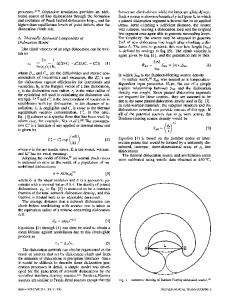Modeling of crack tip dislocation emission in B2 intermetallic alloys
- PDF / 739,956 Bytes
- 7 Pages / 612 x 828 pts Page_size
- 64 Downloads / 416 Views
A model has been previously proposed to describe the energy associated with emission of dissociated superlattice dislocations from crack tips in ordered intermetallic alloys. In the present paper, the model is applied to several B2 intermetallic alloys. The results of the analysis reveal a correlation between the range of slip system orientations for which emission of a dislocation from a crack tip is energetically favorable and the macroscopic fracture mode of the alloy. Additionally, the effects of changing the active slip system, increasing the thermal energy available for thermally activated dislocation emission, and changing the {111} APB energy on the fracture mode of NiAl and FeAl are discussed.
I. INTRODUCTION Brittle fracture at ambient temperatures in intermetallic alloys with the B2 crystal structure can occur by grain boundary separation or by transgranular cleavage. Previous investigators have attributed brittle fracture in B2 intermetallic alloys to environmental effects, impurity segregation to grain boundaries, poor grain boundary cohesion, and violation of the compatibility requirement for polycrystalline deformation.1^1 Intergranular fracture in B2 intermetallic alloys has been extensively studied. In some cases, intergranular fracture can be controlled by alloying additions, such as boron additions to Fe-4OA1.4 The boron segregates to grain boundaries where it is thought to enhance grain boundary cohesion. The compatibility problem arises because the room temperature slip vector of many B2 intermetallic alloys is (100), which does not provide enough independent slip systems for generalized plastic flow of a polycrystalline aggregate.3 The problem of compatibility can be remedied by changing the slip vector. For example, Cr is known to promote (111) slip in NiAl, but an associated increase in tensile ductility has not been observed.5 This suggests that compatibility is a necessary, but not sufficient, condition for ductile fracture in this particular alloy. Grain refinement has been found to inhibit brittle fracture in some B2 intermetallic alloys. It has been proposed that below a critical grain size the stress required to nucleate cracks is less than the stress necessary to propagate them. 36 In contrast to grain boundary fracture, the causes of cleavage fracture in B2 intermetallic alloys are poorly understood. As with other ordered intermetallic alloys, B2 intermetallic alloys generally have low to moderate CRSS (less than G/100), suggesting that inhibition of crack tip plasticity due to restriction of slip is not a supportable explanation for cleavage fracture in these materials. Rice and Thomson7 proposed a general model that could potentially explain cleavage fracture in B2 J. Mater. Res., Vol. 7, No. 4, Apr 1992
http://journals.cambridge.org
Downloaded: 01 Apr 2015
intermetallic alloys. In their model they consider the presence of an atomistically sharp crack in a material under uniaxial stress, and determine if it is energetically more favorable for crack extension or crack tip blunti
Data Loading...











